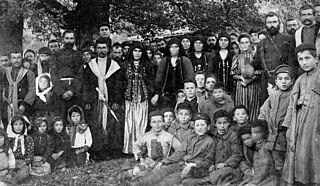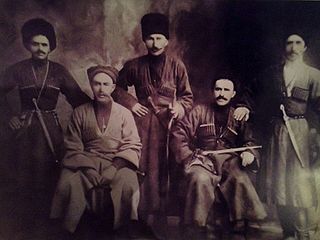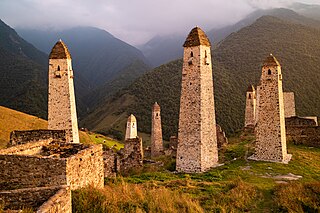Related Research Articles

The Bats people or the Batsbi are Nakh-speaking Tushetians in the country of Georgia. They are also known as the Ts’ova-Tush (წოვათუშები) after the Ts’ova Gorge in the historic Georgian mountain region of Tusheti. The group should not be confused with the neighbouring Kists – also a Nakh-speaking people who live in the nearby Pankisi Gorge.
Yalkharoy is a rural locality in Urus-Martanovsky District of the Republic of Chechnya, Russia.

The Orstkhoy, historically commonly known under their exonyms: Karabulaks, Balsu, Baloy, are a historical ethnoterritorial society among the Chechen and Ingush peoples. Their homeland is in the upper reaches of the Assa and Fortanga rivers in the historical region of Orstkhoy-Mokhk. In the tradition of the Chechen ethno-hierarchy, it is considered one of the nine historical Chechen tukkhums, in the Ingush tradition as one of the seven historical Ingush shahars.
Galashki is a rural locality in Sunzhensky District of the Republic of Ingushetia, Russia, located on the left bank of the Sunzha River near the border with the Republic of North Ossetia–Alania. Its population was about 9,000 people in 2009. Galashki forms the municipality of the rural settlement of Galashki as the only settlement in its composition.
Galanchozh, formerly Akhbosoy, is a non-residential rural locality in Urus-Martanovsky District of the Republic of Chechnya, Russia.

The Feappii were an Ingush subgroup (society) that mostly inhabited the mountainous Fappi region of Ingushetia in the Caucasus. Historically, they bordered on the west with Dzherakh, on the east with Khamkhins, on the north with Nazranians, and in the south with Gudomakarians. The center of the society was the fortified village (aul) of Erzi or Metskhal.

Galashians, were a historical Ingush ethnoterritorial society, which formed in the middle of the 18th century. The name comes from the village of Galashki, which is geographically located in the very center of the society. Galashians were located in the middle and lower reaches of the river Assa and the basin of the river Fortanga.

The Nazranians were a historical Ingush ethnoterritorial subethnic group (society) which inhabited modern day Nazranovsky District and Prigorodny District.

The Dzherakh, also spelled Jerakh, historically also known as Erokhan people, were a historical Ingush ethnoterritorial society, today a tribal organization/clan (teip), that was formed in the Dzheyrakhin gorge, as well as in the area of the lower reaches of the Armkhi River and the upper reaches of the Terek River.
Loamaro — the name of the inhabitants of the mountains in Chechnya and Ingushetia. Loamaro consists of loam (mountain) and the suffix -(a)ro. The ethnonym is literally translated from the Ingush and Chechen language as "mountaineer".

Tsorins, Tsori, also Ghalghaï, were a historical Ingush ethnoterritorial society that was located in mountainous Ingushetia in the region of river Guloykhi. The center of the society was Tsori from which it got its name. Tsorin society, like the Khamkhin society, was formed from the former "Galgaï society" as a result of the transfer (appearance) of rural government to the village Tsori.
Arshty is a rural locality in Sunzhensky District of the Republic of Ingushetia, Russia, located on left bank of the river Arshtynka near the border with the Republic of Chechnya. It forms the municipality of the rural settlement of Arshty as the only settlement in its composition.

Plievo is a rural locality in Nazranovsky District of the Republic of Ingushetia, Russia. It forms the municipality of the rural settlement of Plievo as the only settlement in its composition.

Vilayet Arshtkhoy,Vilayet Arshty,Arshtinskiy Vilayet, was an Ingush administrative unit of the North Caucasian Imamate. It was established on the territory of Orstkhoy society with the center being the village of Arshty.

Ingush okrug was a district (okrug) of the Terek Oblast of the Caucasus Viceroyalty of the Russian Empire. The area of the Ingushskiy okrug made up part of the North Caucasian Federal District of Russia.
Khay is a non-residential rural locality in Achkhoy-Martanovsky District of the Republic of Chechnya, Russia.

Meredzhi is a non-residential rural locality in Galanchozhsky District of the Republic of Chechnya, Russia.

Metskhal is an abandoned aul in the Dzheyrakhsky District of Ingushetia. It is part of the rural settlement of Lyazhgi.
Karabulakskiy Uchastok was a territorial-administrative unit (uchastok) of the Ingushskiy Okrug of the Terek Oblast of the Russian Empire. The area of the Gorsky Uchastok made up Sunzhensky District of Ingushetia and Achkhoy-Martanovsky District of Chechnya.

Erzi is a medieval village (aul) in the Dzheyrakhsky District of Ingushetia. It is part of the rural settlement of Olgeti. The entire territory of the settlement is included in the Dzheyrakh-Assa State Historical-Architectural and Natural Museum-Reserve and is under state protection.
References
- ↑ "Горскій участокъ Ингушевскаго округа — въ 1865 году" [Mountain Uchastok of the Ingushevskiy Okrug – in 1865]. Терскія Вѣдомости. No. 21. Владикавказъ. 21 May 1868. p. 83 (3 as PDF).
- ↑ Сборникъ статистическихъ свѣдѣній о Кавказѣ 1869, p. 43–45.
- 1 2 Грабовскій 1870, p. 115.
- ↑ Албогачиева, Мартазанов & Соловьева 2013, p. 177.
- ↑ Албогачиева 2015, p. 177.
- ↑ Дубровин 1871, p. 381.
- ↑ Сборник свѣдѣній о кавказскихъ горцахъ 1868, p. 6–7.